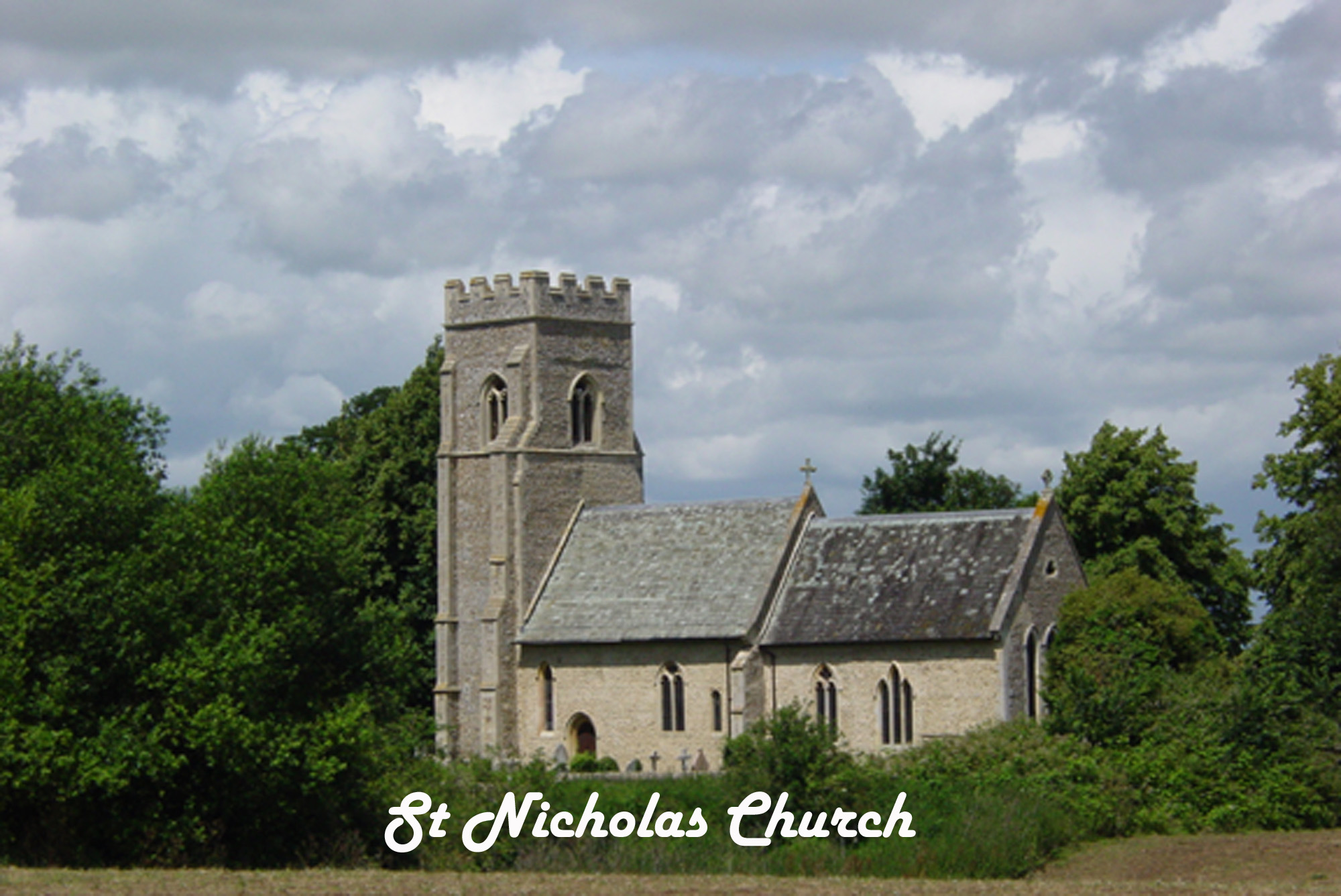
SERVICES at St. Nicholas Church
We have a monthly service at St Nicholas' Church, Kennett on the third Sunday at 3.30 pm. All are welcome.
Services generally last for about 45 minutes, and are aimed at the whole family - children are very welcome, no matter how young.
Easter Sunday 21st April 3.30 communion service
Saturday 27th April - Race Night at the Kentford & Kennett Village Hall to raise funds.
The greatest part of our expenditure goes on the preservation of the building which has survived from the 12th Century, and 2019 will be particularly expensive as we have to renew the roof to the tower.
Please help us keep the church intact through the 21st century.
To find us: at the junction of Church Lane and Dane Hill Road, take the lane down to the church through the wood.
Because of its location, we keep the building locked. If you would like to go inside, please contact one of the Ministry Team for the key.
St Nicholas' Church, Kennett is one of the Three Rivers Group of parishes, which is in the Deanery of Fordham and Quy, Diocese of Ely.
The Three Rivers Group Ministry Team
| Rector | The Rev'd David Cleugh |
| The Vicarage | |
| 24 Mildenhall Road | |
| Fordham | |
| CB7 5NR | |
| Tel: | 01638 723010 |
| Email: | This email address is being protected from spambots. You need JavaScript enabled to view it. |
| Associate Priest | The Rev'd Sue Potts |
| The Vicarage | |
| Chippenham | |
| Tel: 01638 721662 | |
| Email: This email address is being protected from spambots. You need JavaScript enabled to view it. | |
St Nicholas' Parochial Church Council
| Churchwardens | Mrs Betty Lomas |
| Treasurer | Dr Stephen Taylor 01638 720765 |
| Secretary | |
| Key Holder | Mrs Mary Deary, 7 The Close, Kennett |
Cleaning Rota Members
Church should be cleaned in the week before the service at some time please.
Robin and Josephine Swanson, 22 Station Road, Kennett,
01638 750067 This email address is being protected from spambots. You need JavaScript enabled to view it.
Paul and Danielle Swanson, 12 Dane Hill Road, Kennett, CB8 7QY,
01638 750459, This email address is being protected from spambots. You need JavaScript enabled to view it.
Hayley and Andy Dunne, 13 Hornbeam Avenue, Red Lodge, IP28 8YH,
01638 554607, 07977 159813, This email address is being protected from spambots. You need JavaScript enabled to view it.
Betty Lomas, 231 Parkers Walk, Studlands Park, Newmarket, CB8 7AS, 01638 661971
In Remembrance KENNETT - Roll of Honour
This memorial is a plaque inside St. Nicholas Church
| 1914 - 1918 | |
| Harry BARBER | Royal Fusiliers. Acting Corporal, 36318, 11th Battalion. Killed in action Tuesday, 23rd October 1917 in France & Flanders. Age 20. Enlisted Newmarket, resident Kennett. Son of George and Harriett Barber, of Barrow Green, Barrow, Bury St. Edmund's. Commemorated on TYNE COT MEMORIAL, Zonnebeke, West-Vlaanderen, Belgium. Panel 28 to 30 and 162 to 162A and 163A |
| Ernest Thomas BULLETT | Coldstream Guards Pte. 5th Reserve Bt., d 10/2/1915, age 23, wounded at La Bassee and died at Newcastle Hospital. Buried: KENNETT (ST. NICHOLAS) CHURCHYARD, Cambridgeshire, United Kingdom. Son of Walter and Eliza Maria Bullett, of Station Yard, Kennett. Born Kentford, Suffolk, enlisted Walthamstow, Essex, resident Kennett. |
| Arthur Edward HARDING | R.H.A. Drv. 20th Trench Mortar Bty., Royal Field Artillery, died of wounds 5/10/1916, age 26, buried: GROVE TOWN CEMETERY, MEAULTE, Somme, France. Son of Charles and Sarah Ann Harding, of Hall Cottages, Kennett, Newmarket, Cambs. Born Newmarket, enlisted Consett, Durham. |
| Benjamin LAWRENCE | East Kent Reg. 6th Bt. (From gravestone - Gassed 14/3/1916 at Halluch, France, d 2/3/1917 (N.B. 1917 on gravestone, 1919 CWGC - as he does not appear in the SDGW 1919 would seem more appropriate), age 22 at Kennett). Buried in Kennett Churchyard. |
| William MOSS | R.N.probably : William Moss, Boy 1st Class J/22017 H.M.S. "Bulwark.", Royal Navy who died on Thursday, 26th November 1914. Age 17. Son of William and Ann Moss, of Little Livermere, Suffolk. Commemorated on PORTSMOUTH NAVAL MEMORIAL, Hampshire. Panel 3. |
| Albert Edward TIMMINS | Grenadier Guards 3rd Bt., d 8/10/1915, commemorated: LOOS MEMORIAL, Pas de Calais, France. Son of Edward and Martha Elizabeth Timmins. Born Flanhamlock, Brecon, enlisted Bury St. Edmund's. |
| 1939 - 1945 | |
| Roy Ernest NEWMAN | Sgt. 202 Sqdn. R.A.F.V.R., d 4/8/1943, age 22, commemorated: RUNNYMEDE MEMORIAL, Surrey, United Kingdom. Son of Herbert William and Annie Newman, of Kennett, Cambridgeshire. |
| Charles Alexander SORE | Spr. 705 Army Troops Coy., Royal Engineers, d 26/9/1944, age 43, buried: TILLY-SUR-SEULLES WAR CEMETERY, Calvados, France. Son of Henry and Minnie Sore; husband of Mabel Gladys Sore, of Kennett, Cambridgeshire. |
| [Frederick] Walter Ollis STREET-PORTER | F/O, 114 Sqdn. R.A.F.V.R., d 14/1/1942, commemorated: RUNNYMEDE MEMORIAL, Surrey, United Kingdom. |
| Kenneth Reginald TURNER | Possibly: Flt. Sgt. 55 Sqdn., R.A.F., d 7/4/1944, age 21, buried: ASSISI WAR CEMETERY, Italy. Son of Reginald Ernest Willie and Elizabeth Mary Turner. |
St Nicholas Church, Kennett, listed building description
Grade: IIs Listed Description:
Small parish church with an original early C13 nave, north aisle, and chancel extended later in C13 by one bay with three very fine windows and double piscina.
The tower appears to be late C13 or early C14, and to have been completed later in C14. The north doorway is transitional in style and noteworthy. The north porch, chancel arch and screen, and tower arch are C15. The roofs are modern and were possibly rebuilt after wartime bomb damage. Walls of flint and rubble originally plastered, with limestone and clunch dressings, clunch arcade, piscina and openings. Graded slate gable roofs with modern stone parapets and kneelers.
West tower and angle buttresses of four stages; embattled parapet, shallow plinth. Sealed belfry lights to west facade, two centred west doorway arch of two chamfered orders, second stage three light window in two centred arch with intersecting mullions; belfry window of two, cinquefoil lights with a quatrefoil in two centred arch.
North elevation: north porch has partly resorted C15 moulded arch. North doorway with round headed arch and label terminating at moulded imposts has two slender detached ringed shafts with water leaf capitals and moulded bases. North aisle, unbuttressed, with long and short stone quoins, similar to rear wall of tower and with original flint courses has three lancet windows, one a modern replacement.
Chancel, with original C13 flint coursing has a straight joint where it was extended later in C13. The lancet sanctuary windows, all partly restored, have detached shafts with deeply moulded bell capitals and bases, those in the east window have shafts with rings. The north window has two lancet lights, the south window three, and the east window three lights with a common label and head stops. The late C13 double piscina with foiled drains has two deeply moulded two centre arches with trefoiled inner arches, divided by detached shafts with deeply moulded caps and bases. Label has finely carved foliate stops and central boss.
North arcade of three bays and one bay terminating in wall of tower has two centred, steeply pitched arches of two chamfered orders with labels; octagonal piers with plain capitals and bases. C15 tower arch and chancel arch, two centred with two chamfered orders, moulded capitals and bases and semi octagonal piers. The screen, contemporary with the chancel arch is carved on both sides, the central arch a blind ogee with rosettes in the spandrels was once painted. The font, early C14 square limestone with chamfered corners stands on single shaft with moulded capital and base and square plinth. Stained glass windows, C19, by A Gibbs, 38 Bedford Street, London.
Additional Information:
Formerly listed grade A: , as Church of St Nicholas, List No 17/1.
Grade amended and address amended at Date Listed: 01/12/51
Grid Reference:
TL 69986835 Easting: 5699800 Northing: 2683500
Church History
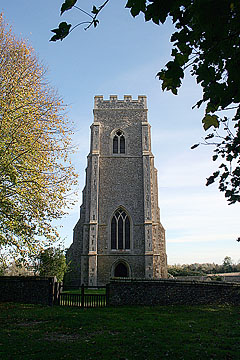 In 1256 Kennett had a church, whose advowson remained in the hands of the lords of the manor throughout the Middle Ages. In 1557 John Willoughby, held the right of presentation, which was exercised by successive lords of the Petre family in the late 16th century. In 1643 John Chenery presented Oliver Bryant, suggesting that the Petre family had sold that turn, but in 1696 the lord of the manor, Sir Samuel Barnardiston, presented. The advowson remained attached to the lordship during the 18th, 19th, and early 20th centuries, but in 1751 the bishop presented by lapse. In 1958 the advowson was not sold with the lordship to Mr. G. Lofts, although he believed that he had the right to choose the rector. In the late 20th century the patronage was held by the heirs of Mrs. Sickles, who lived in Philadelphia (U.S.A.). Proposals to unite the benefice with the neighbouring living at Chippenham in 1929 came to nothing, owing to the opposition of Kennett's squire. The living was nevertheless thereafter held in plurality with neighbouring livings in Suffolk and Cambridgeshire, and since 1974 was held with neighbouring Fordham, whose vicar was in charge at Kennett in 1997.
In 1256 Kennett had a church, whose advowson remained in the hands of the lords of the manor throughout the Middle Ages. In 1557 John Willoughby, held the right of presentation, which was exercised by successive lords of the Petre family in the late 16th century. In 1643 John Chenery presented Oliver Bryant, suggesting that the Petre family had sold that turn, but in 1696 the lord of the manor, Sir Samuel Barnardiston, presented. The advowson remained attached to the lordship during the 18th, 19th, and early 20th centuries, but in 1751 the bishop presented by lapse. In 1958 the advowson was not sold with the lordship to Mr. G. Lofts, although he believed that he had the right to choose the rector. In the late 20th century the patronage was held by the heirs of Mrs. Sickles, who lived in Philadelphia (U.S.A.). Proposals to unite the benefice with the neighbouring living at Chippenham in 1929 came to nothing, owing to the opposition of Kennett's squire. The living was nevertheless thereafter held in plurality with neighbouring livings in Suffolk and Cambridgeshire, and since 1974 was held with neighbouring Fordham, whose vicar was in charge at Kennett in 1997.
The living remained an unappropriated rectory during the Middle Ages. In 1279 the rector had 30 a. of glebe. During the 17th and early 18th centuries the 35 a. of glebe was divided between the three fields in 24 blocks of 1/2-2 a. Under the inclosure award of 1823 the rector was allotted 31¾ a. His main portion, 29 a. of arable, lay south of the church. The new rectory house was built on that land in the early 1830s, reducing the arable to 28 a. In 1912 a plan to sell the glebe to the lord was rejected, but 3/4 a. was sold in 1925 at the insistence of the rector. In 1947 the remaining glebe was sold, except for 3/4 a. reserved as the site for a new rectory house, but finally sold in 1967.
In 1254 the rectory was valued at £8, and the rector received another 5s. from land in neigh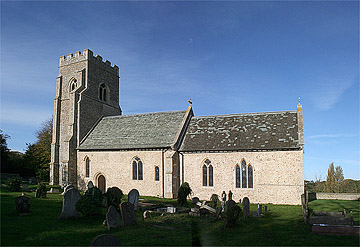 bouring Elveden (Suff.). In 1291 it was taxed at £12, and in 1535 valued at £11 10s. 8d. In the late 13th century the lord of the manor paid part of his tithe in kind with corn, and calves. About 1650, when the tithes were often taken by composition, the rectory yielded c. £60 a year, and was worth no more in the early 18th century. In the 1830s the gross income of the living was £135 a year, its net income £116. In 1837 the rector was awarded a rent charge of £200 in lieu of his tithes: in 1851 his gross income was £223, comprising £200 from commuted tithes, and £23 from the glebe rent. By 1887 the worth of the living had declined to £180 gross, and in 1928 the glebe rent had fallen to only £5. In 1929 the rector's request for an augmentation was rejected, but in 1931 he was given an additional £13 a year.
bouring Elveden (Suff.). In 1291 it was taxed at £12, and in 1535 valued at £11 10s. 8d. In the late 13th century the lord of the manor paid part of his tithe in kind with corn, and calves. About 1650, when the tithes were often taken by composition, the rectory yielded c. £60 a year, and was worth no more in the early 18th century. In the 1830s the gross income of the living was £135 a year, its net income £116. In 1837 the rector was awarded a rent charge of £200 in lieu of his tithes: in 1851 his gross income was £223, comprising £200 from commuted tithes, and £23 from the glebe rent. By 1887 the worth of the living had declined to £180 gross, and in 1928 the glebe rent had fallen to only £5. In 1929 the rector's request for an augmentation was rejected, but in 1931 he was given an additional £13 a year.
There was a parsonage house in 1279. In 1674 it had 4 hearths, and in 1712 a barn and stable yard were attached to it. The rectory house, which may have stood north-east of the parish church beside the old village street, was dilapidated and probably demolished in the late 1840s. William Godfrey, however, reported ample accommodation in 1851. In 1897 a new rectory was built opposite the church at the southern end of the village street. Between 1901 and 1929 it was occupied by successive rectors. In 1937 the drainage was improved, and a modern bathroom installed. That house, however, was too large to maintain, and in 1947 it was sold off, remaining in private ownership thereafter.
In the 14th century Kennett was held successively by six rectors, one serving for 33 years. There was a rapid succession of six rectors between 1439 and 1465, but John King served from 1465 until 1509. In the 16th century the parish was served by eight rectors: James Slater was deprived in 1555 for simony. His successor remained in office until 1580. In the early 17th century successive rectors held the living in plurality with neighbouring parishes in Suffolk. In the late 17th and early 18th centuries John Fairclough (d. 1696) and his son Richard (d. 1751) served in succession, effectively acting as squires. The living was held by John Bullen, 1756-75, and by his son Thomas, 1810-13, in plurality with livings in Suffolk, while Anthony Richardson was rector during the intervening years. In 1806 he preached at Kennett on every Sunday. George Mingay, who took over as vicar in 1813, also conducted services c. 1813-20 in Chippenham and Wicken for their absentee incumbents. After 1827, following his appointment as chaplain to the duke of Rutland and rector of Wistow (Hunts.), he was probably rarely at Kennett, resigning in 1833.
His successor, William Godfrey (d. 1900), was a popular incumbent, respected and admired by the parishioners. He paid for the restoration of the parish church in 1859, and brought numerous benefits to the village. Problems, however, arose after his death as a result of confusion between glebe and manorial land. His successor resigned in 1912 to take over the neighbouring living at Chippenham. Ernest Wooton served Kennett until he resigned in 1929 because of old age, under pressure from the patron and his ecclesiastical superiors. Wooton also served Kentford, assisted by a curate, and sought to improve the value of Kennett.
Between 1603 and 1676 the number of communicants increased from 50 to 63. The number receiving communion was c. 20-25 in the early 19th century, but in 1873 had risen to 46, before falling back to c. 23-25 c. 1885-97. Communion was celebrated four times a year in 1806 and 1820, in 1813 only three times a year, and in 1873 there was only one celebration a year. There was one service every Sunday during the early 19th century, and by 1851 two morning services and an evening one. Both in 1851 and in 1897, although there were no dissenters, about a third of the adult parishioners did not regularly attend church.
The parish church, named for ST. NICHOLAS by 1279, stood next to the main village street until c. 1865-73. After the diversion of the road eastwards it was approached by a hedge-lined avenue. Its design has been described as 'a miniature Ely cathedral', with its 15th-century west tower dominating the church and the surrounding landscape.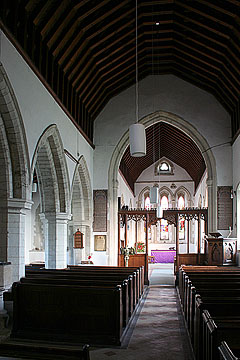
The church, built of flint and rubble, also includes a chancel and an aisled nave with north porch. The nave and north porch date from the late 12th and early 13th centuries, and the chancel from the 13th century. The lancet windows at the east end date from the late 12th century or early 13th. In the nave there are 14th-century arcades of four bays, 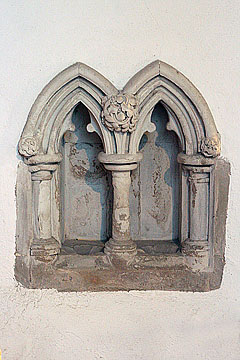 with octagonal piers and double chamfered arches, and a 14th-century rood screen and font. The double piscina dates from the 13th century, and has flowered drains and grape clusters carved at the ends of the moulded arches. In 1859 the church was thoroughly restored at the rector's expense, and in 1866 his sister paid for new stained glass. The church plate and oak altar are mid 19th-century. There are memorials to Sarah Chenery (d. 1607), and to Oliver Godfrey (d. 1817) and his son William (d. 1843) and grandson William (d. 1900), set on the south wall of the chancel and in the west wall of the nave. There are three bells, one of which dates from the 13th century. An organ, built by the students of Soham village college in the 1960s, is placed on the north wall of the chancel. The rector J. C. F. Hood left £250 for the maintenance of the church in 1957. A new burial ground of 8,100 sq. ft. was laid out beyond the churchyard walls in 1985. In 1996 masonry bees ate into the church walls and damaged the flints.
with octagonal piers and double chamfered arches, and a 14th-century rood screen and font. The double piscina dates from the 13th century, and has flowered drains and grape clusters carved at the ends of the moulded arches. In 1859 the church was thoroughly restored at the rector's expense, and in 1866 his sister paid for new stained glass. The church plate and oak altar are mid 19th-century. There are memorials to Sarah Chenery (d. 1607), and to Oliver Godfrey (d. 1817) and his son William (d. 1843) and grandson William (d. 1900), set on the south wall of the chancel and in the west wall of the nave. There are three bells, one of which dates from the 13th century. An organ, built by the students of Soham village college in the 1960s, is placed on the north wall of the chancel. The rector J. C. F. Hood left £250 for the maintenance of the church in 1957. A new burial ground of 8,100 sq. ft. was laid out beyond the churchyard walls in 1985. In 1996 masonry bees ate into the church walls and damaged the flints.
The small rhyme commemorates Sara Chenerye, who died in 1607 at the age of 25, during childbirth. Two more limina, I thought: the mightiest of all.the Chenerye brass
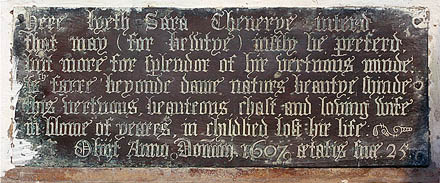 [The inscription says : here lyeth Sara Chenerye interd, that may (for bewtye) iustly be preferd, but more for splendor of hir vertuous minde, so faire beyonde dame naturs beautye shinde this vertuous, beauteous, chast, and loving wife in blome of yeares, in childbed lost hir life. Obiit Anno Domini 1607 aetatis sua 25.]
[The inscription says : here lyeth Sara Chenerye interd, that may (for bewtye) iustly be preferd, but more for splendor of hir vertuous minde, so faire beyonde dame naturs beautye shinde this vertuous, beauteous, chast, and loving wife in blome of yeares, in childbed lost hir life. Obiit Anno Domini 1607 aetatis sua 25.]
